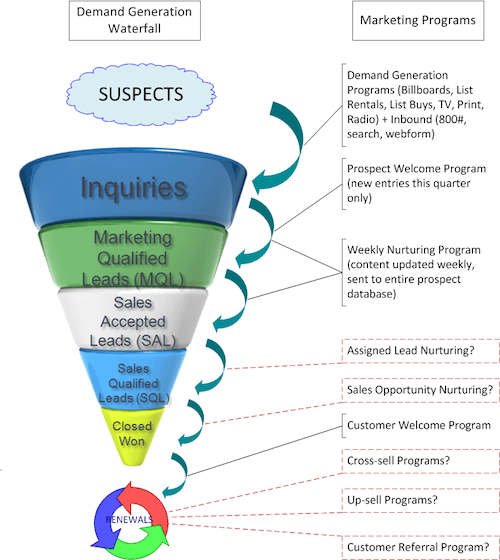Are you cultivating the leads who are not ready to buy today?
80% of the leads who don't buy from you will go to buy from someone else according to Eloqua, or more specifically Steve Woods, their CTO, in his excellent book Digital Body Language. It's shocking in one sense, since it means there's a big missed opportunity. The potential customer was interested enough to give us their details, but not enough to buy. But it's not surprising in another sense in that we (as marketers) are not inspiring the lead to buy, and many have a need which will be met by another company.
So what's the answer? Lead nurturing, part of the marketing automation software process. I read this great post by Baxter Denney on the Marketing Automation Guide last month and wanted to give you my take on it. It starts with the classic conversion funnel which shows their model - it's always good to see how others tackle this. I enjoyed Baxter's diagram - the red outline boxes are where he spotted lead nurturing for a particular client of his (so it demonstrates the before and after). All those stages may not apply to you, but still the thinking is, I'm sure, very relevant to you too.

Getting started with lead nurturing
Let's start with what's involved with lead nurturing? Here's a simple definition:
“At its core, lead nurturing is the process of cultivating leads that are not yet ready to buy.” Eloqua.com
At the heart of what both Eloqua and Baxter Denney are recommending is this: Focus on your leads and their problems and pain points. Segment around that and also take in to account where those personas are in the buyer process, overlay that. Maybe that will give you somewhere between 4 and 8 segments.
Build on the segments that you know:
"Focus on lead nurturing not just as a means to keep prospects warm… offer them appropriate content based on where they are in the decision-making [buyer] process." Baxter Denney
Here's a simple four step process to getting started, which I tend to use on projects:
- Understand the major persona [buyer] types for your organisation. Segment enough without needlessly complicating it. I would't create more than three or four initially, it's too much. And, let's face it you're probably assuming just one at the moment! Use data, chat with sales guys, dig out old plans. Who are the buyers - use motivation and problem definition as the means to segment since demographics is way less relevant method these days.
- Map the journeys of those personas, where do they typically come from (channels), where are the communication gaps where your lads fall away and get picked up by your competitors?
- Define the audience content interests by understanding their problems perceived by the leads at those stages? What would people value from you? Marketing needs to deliver on this. What format is helpful to those leads. This is the core of the lead nurturing process - help those people remove the blocks that are between them and the sale. Think about great email content + landing pages + videos + webinars + ebooks. There's a lot to go at!
- Rinse and repeat, you'll get lots more insight by monitoring and improving the process - view it as an ever improving live test over a fait accompli. Survey's, analytics, talking the sales people are all means to garner insight for improvement. Evolve and improve something every month.
- I know I said four - but one other tip. Lead nurturing instinctively says email for many reasons, and it mostly is for those reasons. However! If you're really thinking about people, over selling, consider relevant means of communication as it makes financial sense. Test direct mail, automate outbound calls (they don't have to be salesy!) at the right time. The old direct marketing principals still apply.
Improving how to use segmented email campaigns
How you can improve automate of email to help with lead maturation is an essential question to think about.
I hope that the thinking above demonstrated that there's so much focus today on the tactical use of email, using segmentation but still assuming that most people are ready to buy, and so as marketers all we do is directly promote in some shape or form. The one liner is simple, and maybe a little cutting: You're selling at pretty much every level of your marketing. This alienates since the potential customer is worried about their unmet need - not your latest offer. I'm guessing you're 'traditional' email marketing will cover 3 areas:
- Some form of welcome / thanks for registering or signing up
- Weekly email programmes that will most likely be sent en masse (some companies will have a few segments)
- A thanks for buying email, usually more operational in its content
The challenge is that you're interested in you and what you have to say about your product or service, and you're segmenting and 'optimising' around that focus, I'd suggest you can only ever take this so far before you run out of steam for the simple fact that most of your leads are not ready to buy, yet. They're earlier in the decision making process, and they're worried about them. Turn the idea of marketing to anonymous your leads into persona types, people in different scenarios with varying purchase intent whom you can nurture through that funnel. Imagine how differently you'll come across to you competitors.








